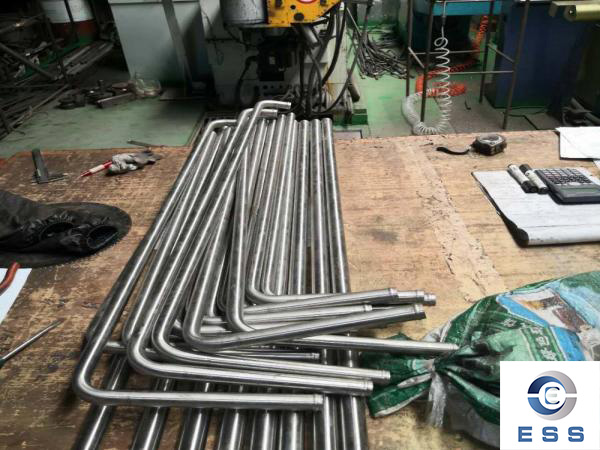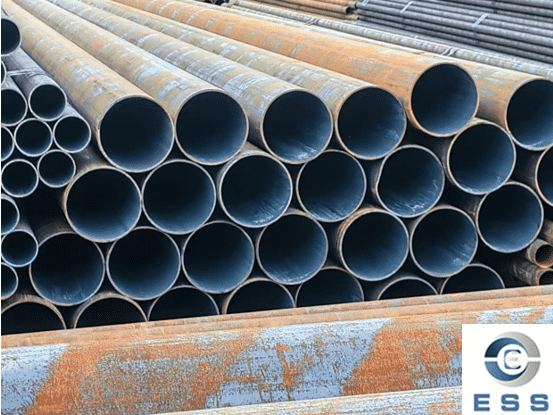Surface quality defects of seamless hydraulic tubes (continuous cast round tube blanks)

Surface cracks on the tube blank: vertical cracks, transverse cracks, network cracks.
Causes of vertical cracks:
1. The bias flow caused by the misalignment of the nozzle and the crystallizer washes away the solidified shell of the tube blank;
2. The meltability of the mold slag is poor, and the liquid slag layer is too thick or too thin, resulting in uneven slag film thickness and making the local solidification shell of the tube blank too thin.
3. Crystallization liquid level fluctuation (when the liquid level fluctuation is > ± 10mm, the crack occurrence rate is about 30%);
4. P and S content in steel. (P ﹥ 0. 017%, S ﹥ 0. 027%, longitudinal cracks increasing trend);
5. When the C content in steel is between 0. 12% and 0. 17%, longitudinal cracks tend to increase.
Precaution:
1. Ensure that the nozzle and the crystallizer are aligned;
2. The crystallization liquid level fluctuation must be stable;
3. Use an appropriate crystallization taper;
4. Select mold powder with excellent performance;
5. Use a hot-top crystallizer.
Causes of transverse cracks:
1. Too deep vibration marks are the main cause of transverse cracks;
2. Increased content of (niobium, aluminum) in steel is the inducing cause.
3. The tube blank is straightened when the temperature is 900-700℃.
4. The secondary cooling intensity is too large.
Precaution:
1. The crystallizer adopts high frequency and small amplitude to reduce the depth of vibration marks on the inner arc surface of the slab;
2. The secondary cooling zone adopts a stable weak cooling system to ensure that the surface temperature is greater than 900 degrees during straightening.
3. Keep the crystal liquid level stable;
4. Use mold powder with good lubrication performance and low viscosity.
Causes of surface network cracks:
1. The high-temperature cast slab absorbs the copper in the mold, and the copper becomes liquid and then oozes out along the austenite grain boundaries;
2. Residual elements in the steel (such as copper, tin, etc.) remain on the surface of the tube blank and seep out along the grain boundaries;
Precaution:
1. The surface of the crystallizer is chromium plated to increase surface hardness;
2. Use an appropriate amount of secondary cooling water;
3. Control residual elements in steel.
4. Control the Mn/S value to ensure Mn/S > 40. It is generally believed that when the surface crack depth of the tube blank does not exceed 0. 5mm, the cracks will be oxidized during the heating process and will not cause surface cracks in the steel pipe. Since the cracks on the surface of the tube blank will be severely oxidized during the heating process, the cracks are often accompanied by oxidation particles and decarburization phenomena after rolling.
Scarring and heavy skinning of tube blanks:
Causes: The temperature of the molten steel is too low, the molten steel is too sticky, the nozzle is blocked, the injection flow deviates, etc. The outward folding of the steel pipe caused by the surface scarring and heavy skinning of the tube blank is different from the scarring and outward folding defects of the blank tube produced during pipe rolling. It has very obvious oxidation characteristics, accompanied by oxidation particles and severe delamination. Carbon phenomenon, ferrous oxide exists at defects.
Air pores in the tube blank: Generally, some small pores are formed on the surface of the tube blank due to the bursting of subcutaneous bubbles during the casting process of the molten steel. After the tube blank is rolled, small flying skin will be formed on the surface of the steel pipe.
Tube blank pits and grooves:
The causes of pits and grooves in the tube blank: On the one hand, it may be caused by the crystallization process of the billet, which is related to the too large taper of the mold or the uneven cooling of the secondary cooling zone; on the other hand, it may be caused by the still life of the billet. It is caused by mechanical bumps or scratches on the surface of the tube blank when it is not completely cooled. After perforation, folds or scabs (pits) and large outward folds (grooves) are formed on the surface of the capillary tube.
The "ears" of the tube blank: Mainly due to the fact that the roll gap (the straightening roller of the continuous casting machine and the roll of the rolling mill) is not closed. When the tube blank is stretched, straightened or rolled, the tension and straightening roller or the rolling roller is pressed down. The amount is too large or the roll gap is too small. Caused by too much wide metal entering the roll gap. After perforation, the surface of the capillary tube produces a spiral outward fold. Regardless of the surface defects of the tube blank, defects may form on the surface of the seamless steel pipe during the pipe rolling process. In serious cases, the rolled steel pipe will be scrapped. Therefore, it is necessary to strengthen the control of the surface quality of the tube blank and the removal of surface defects.Only tube blanks that meet the standard requirements can be put into tube rolling production.













 Eastern Steel Manufacturing Co.,Ltd not only improve product production and sales services, but also provide additional value-added services. As long as you need, we can complete your specific needs together.
Eastern Steel Manufacturing Co.,Ltd not only improve product production and sales services, but also provide additional value-added services. As long as you need, we can complete your specific needs together.










